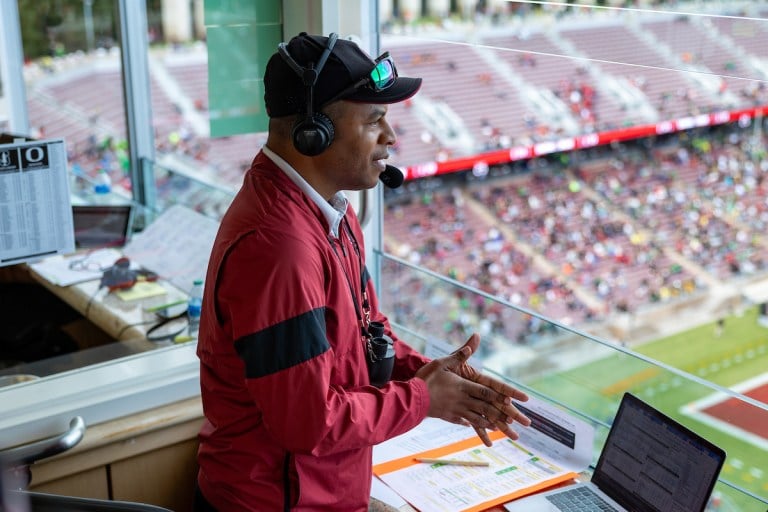Most people start preparing for a job after they are officially offered a position.
But not Stanford alum Troy Clardy ’97, who was prepared to call the Cardinal’s first football game against Hawaii this season before he was offered play-by-play announcer role for Stanford football and men’s basketball.
“I started prepping for the season-opener just in case I got the gig,” Clardy said. “Preparation is a never-ending process.”
Clardy received a phone call in August and was formally offered the role.
“Stanford’s a special place, and a lot went into having that degree on my wall,” Clardy said. “Getting that phone call to get the offer for the job was truly special and a culmination of a dream come true.”
Athletics Director Bernard Muir told Stanford Athletics that “Troy has always been a loyal ambassador for Stanford Athletics and is uniquely positioned to share the stories of our student-athletes and programs.”
For those who have listened to Clardy, his excitement and high energy are among his most well-known attributes. In-person, it would be difficult to find Clardy without a cheerful expression on his face. But behind the veteran sportscaster’s beaming smile is a resolute individual, who has earned his stripes in the cutthroat industry of sports broadcasting.
To long-time fans of Stanford athletics, Clardy is a familiar name. The broadcaster spent the better part of three decades providing consistent coverage for Stanford men’s and women’s sports, including stints at San Francisco radio stations KTCT and KTRB.
He also contributed with play-by-play commentary for the Pac-12 network and hosted TreeCast since 2015, a podcast which includes commentary, analysis and exclusive interviews for Stanford sports fans.
His deep-rooted connection to Stanford sports extends back to his undergraduate years, where he got his start in sports broadcasting calling football and baseball games for KZSU, Stanford’s FM radio station. Thanks to the performance of both the football and baseball teams, Clardy was able to provide commentary on significant games even as a young adult.
“By the time I graduated I had done a Liberty Bowl, a Sun Bowl and a College World Series,” Clardy said. “There are a lot of folks who can be in this industry and not be fortunate enough to call events on that scale.”
Before committing to broadcasting, Clardy had planned to become an architect. However, one game changed his career trajectory.
During the 1995 season, the Cardinal were massive underdogs when they hit the road to play the Oregon Ducks, who had just come off a Rose Bowl season. Head coach Tyrone Willingham was an unknown figure at the time.
“Nobody gave Stanford a chance of going up to Eugene, Oregon and getting it done,” Clardy said. “Oregon’s quarterback throws three interceptions and Marlon Evans ’96 takes a kickoff for a touchdown and Stanford ends up winning 28-21.”
The thrill of calling an upset victory prompted Clardy to re-evaluate his career: “I remember being on the plane, heading back with the team and thinking ‘This feels pretty cool!’ … Let’s see how many times I can get this feeling.’”
After graduating from Stanford, Clardy landed a job at the Stanford radio network, where he covered football and men’s basketball. Clardy also has extensive experience working in sports talk radio, hosting shows in the Bay Area and Pittsburgh, and even working for other nationally syndicated broadcasts like ESPN Radio.
Clardy’s ascent within the broadcast field is certainly no shock to his media colleagues. “Troy is down to earth, talented and versatile,” wrote Bryan Fenley, a sportscaster with Fox Sports Radio and ESPN. “All of those characteristics, I believe, are what will lead to success in this industry.”
But in addition to those qualities, Clardy possesses an inordinate work ethic, perhaps the most important trait of all. This includes a process of meticulous preparation to give big sports moments the appropriate weight and time.
For Clardy, the prep process for each game usually involves doing in-depth research on team rosters, talking with coaches and watching prior games.
Clardy described the process as a survey of the 45 to 50 players he expects to see. “I’ll go through the biography they have on the school website and also try to get stories and news clips from local media,” Clardy said.
He also watches previous games to “get an idea of personnel and scheme.”
The commitment to bringing high-quality broadcasts for the viewer is one shared by Clardy and Stanford color analyst John Platz ’83 J.D. ’89 MBA ’89.
“I’ve enjoyed the first few broadcasts that Troy and I have worked together as Stanford’s radio team. We have been acquaintances for many years; he has the same high standard that I do as far as putting out a quality on-air product,” Platz wrote. “These helpful commonalities translate to an enjoyable in-booth experience for each of us and — as a result — a good listening experience for our radio audience.”
Throughout his career, Clardy has documented some of the most exciting moments in Stanford athletics history, like the 1998 Final Four run and the streak of BCS bowls the Cardinal went to in the early 2010s. He — and many in his community — hope he can capture many more.
